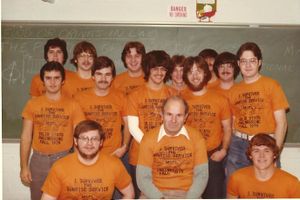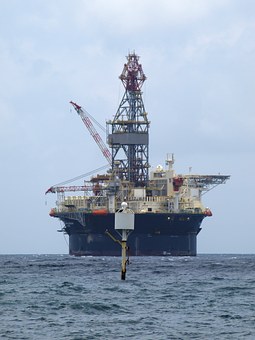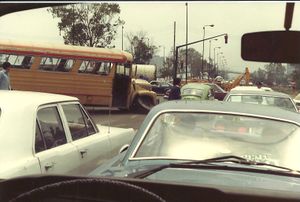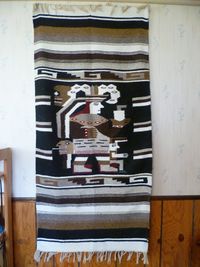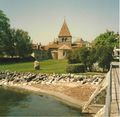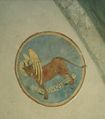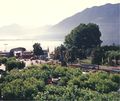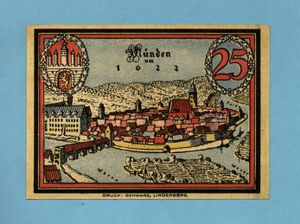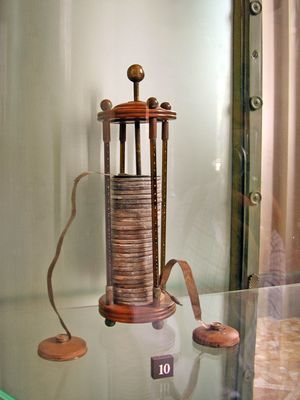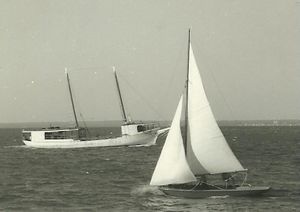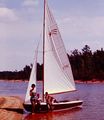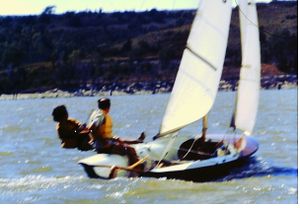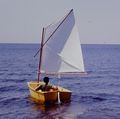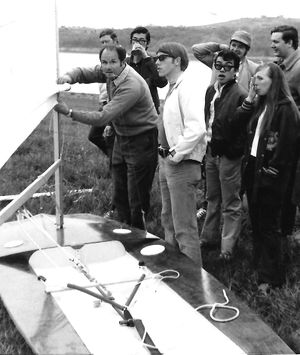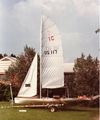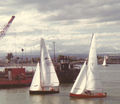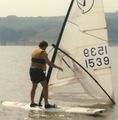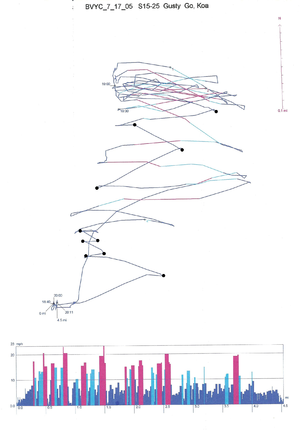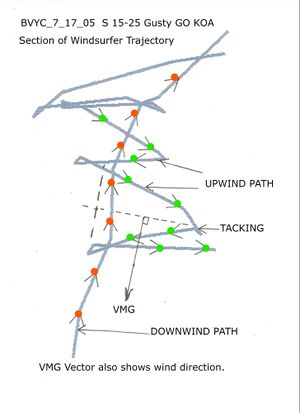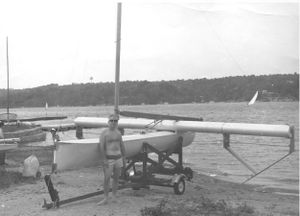First-Hand:Surfing the Waves of Technological Change. Part Two
Academia: Hands On Laboratories in the Ivory Tower
Michael S. P. Lucas, Life Fellow
This is an in depth look at my time at Kansas State University from 1968 to 1995. I had met W.W. Koepsel, the department head of KSU Electrical Engineering at Duke University. He had invited me to move to Manhattan and start a program in Solid State Engineering. The EE Department already had a course outline and approval for the new course. So I arrived and took over an empty laboratory space and and a small budget for laboratory equipment.
To recap from Part One, we arrived in Manhattan, Kansas in August 1968 almost broke but with a prospective nine month salary of around $14,000. We found inexpensive rental housing around the corner from where we live today. At the University I was provided with a large basement office with a dismal view and decrepit steel furniture. I also acquired basement laboratory space with a basic fume hood. I had been hired to start a program in what was then termed Solid State Engineering. Much of the Electrical Engineering Department research money was being used to refurbish an ancient Cockcroft Walton accelerator with the object of using it for ion implantation in silicon wafers. So there was a limited amount of money available for laboratory equipment. This was the beginning of Begging Bowl Electronics.
Transistors and Logic Families
Transistors in their various manifestations were probably the most important inventions ever made considering their overall influence on technology and society. What is so interesting is that the first working device, the point contact transistor made at Bell Telephone Laboratories in December 1947, was similar to a crystal radio diode with an extra cat's whisker connection. Apparently it was made to work by trial and error which was the usual technique with crystal radios. The inventors John Bardeen, William Shockley, and Walter Brattain received the Noble Prize for their work in 1956.[1] In 1951 Shockley and his group made the first working germanium junction transistor.[2] The first working silicon transistor was developed at Bell Labs on January 26, 1954 by Morris Tanenbaum. The first commercial silicon transistor was produced by Texas Instruments in 1954. [3] In 1958 Jack Kilby, who grew up in Great Bend, Kansas, produced the first integrated circuit on a piece of germanium.[4] At the time of his invention he was a new employee at Texas Instruments. He received the Nobel Prize for his work in the year 2000.
The invention of the integrated circuit accelerated the growth and performance of the various logic families eventually leading to the availability of microcontrollers and microcomputers. [5] Some of the early logic circuits had been used with vacuum tubes and discrete components: for example RTL, DTL and ECL. TTL in its several variations was most used until RCA produced CD4000 COS/MOS in 1968. This opened the door for low power instrumentation and was used in most of our circuits for the next 25 years.
Begging Bowl Electronics
The Thin Film, Thick Film, Simple Silicon Era
There was one tremendous resource available in the Electrical Engineering Department: our students. They were extremely bright people eager to do hands on work with what was at that time exciting State-of-the Art technology. I had a mixture of farm boys who were used to fixing any kind of broken equipment, mature ex military personnel who knew how to get things done and bright foreign students mainly from China and India.
We had the chemical fume hood so I had Ben Lin investigate electroless deposition of thin films. This is a similar process to electroplating. In the meantime we had found a surplus vacuum system and various power supplies. Russ Eberhart, who knew Dr. McCain, the University President, was able to obtain a special grant for supplies and smaller items of equipment. The details of this stage of the laboratory development are described in Thick Film Microcircuit Laboratory by Lucas and Dawes. The next part of my narrative is woven around the chronological list of student reports, theses and dissertations.
MS & PhD Student Reports, Theses and Dissertations.
1969 Ben H. Lin, "Investigation of Electroless Deposition for Thin Films in Integrated Circuits."
1969 Russell C. Eberhart, "Considerations in the Design and Utilization of Sputtering Systems."
1970 K. N. Rao, "Investigation of the Microcomb Capacitor."
1972 Russell C. Eberhart, "Crop Thinning Control System Design." (Ph.D. Dissertation)
1972 S. S. Dhaliwal, "Fabrication of Bipolar Junction Transistors."
1972 William H. Dawes, "Fabrication of an Experimental N-Channel Insulated- Gate Field Effect Transistor."
1973 R. K. Blocksome, "A Telemetry Transmitter for Highway Data Collection."
1974 Michael R. Casey, "A Thick Film Hybrid Circuit Laboratory Manual."
1974 William H. Dawes, "Design and Fabrication of RC Logarithmic Analog-to- Digital Converters for Cobalt Oxide Humidity and Temperature Sensors." (Ph. D. Dissertation)
1977 Peter J. Connor, "An Investigation of Integrated Injection Logic."
The Instrumentation Era
The work on thin and thick films rapidly became obsolete as silicon technology advanced and we were unable to find the money to compete. However this rapid advance of silicon technology made inexpensive Opamps, ADCs and Microprocessors available. We were then able to migrate the laboratory to working with low-power instrumentation and testing. Now we were able to provide graduates with much needed skills in an area of great demand. Some funding was provided by the Department but we had to hustle for the rest, a list of various sources of funds and amounts is in Grants and Contracts. The following chronological list of titles illustrates the changes of technology with time and is pretty much self explanatory.
Teaching went on in parallel with the research with some humorous student protests about an early class time.
1979 Donovan J. Nickel, "An Evaluation of Various Microprocessor Implementations of an Adaptive Digital Predictor for Intrusion Detection."
1979 Greg Degi, "An Instrumentation Laboratory Computer System."
1979 R. C. Hochberg, "A Low Power Data Acquisition System."
1981 Dwight R. Palmer, "Some Uses of a Microprocessor in Transducer Systems."
1981 Mac. A. Cody, "An Evaluation of the NSC800 8-Bit Microprocessor for Digital Signal Processing Applications."
1982 Dwight W. Gordon, "An NSC800 Development System."
1982 Nagabushan K. Bhaskara, "Motorola MC68701 Microcomputer Interface for the HP6940B Multiprogrammer."
1983 Krishna Chandra Shekar, "Simple Low Cost Techniques for Frequency Synthesis."
1983 Mahmoud Fawzy Wagdy, "Techniques for Computer Controlled Instrumentation." (Ph.D. Dissertation).
1983 Neufito Fernandes, "An Automated Laboratory Test System."
1984 Ashok Ramachandran, "Design of a Microprocessor based Instrumentation Module for Signal Processing Applications."
1984 Charles R. Ragsdale, "Some Considerations in the Design of a Low-Power,15-Bit, Analog-to-Digital Converter."
1984 Kenneth L. Albin, "An Evaluation of Rockwell's Advanced Architecture Microprocessor for Digital Signal Processing Applications."
1984 Madhukar Duggirala, "Applications of Signal Processing Techniques in Microprocessor based Instrumentation."
1984 Timothy J. Sobering, "The Design of Low-Power, High-Resolution,Analog-to-Digital Conversion Systems with Sampling Rates lessthan 1 kHZ."
1984 William G. Reed, "The Use of Low Power Operational Amplifiers in Track-and-Hold Amplifiers."
1985 Archana Gharpuray, "GPIB Interface for Testing and Controlling Laboratory Projects."
1985 Douglas W. Doerfler, "Techniques for Testing a 15-Bit Data Acquisition System."
1985 Farnad Sajjadian, "A 10 MHz Flash Analog-to-Digital Converter System for Digital Oscilloscope and Signal Processing Applications."
1985 John R. Rasure, "Real-Time Adaptive Control of a Robotic Manipulator Using Three-Dimensional Stereoscopic Vision Feedback." (Ph.D. Dissertation).
1985 Linley E. Woelk, "Digital Generation of Low Frequency, Low Distortion,"
1985 Ravi Pragasam, "The MC68701 Based Spectrum Analyzer."
1986 Jeffrey D. Bradley, "Some Further Considerations in the Design and Implementation of a Low-Power, 15-Bit Data Acquisition System."
1986 Kenton D. Harbour, "A Data Acquisition System with Switched Capacitor Sample-and-Hold."
1987 Richard C. Hochberg, "Optically Coupled Tactile Sensor Array for Robotics." (Ph.D. Dissertation) Joint supervisor with D.H. Lenhert.
1988 Kah Nee Ong, "Improvements in Radiation Detection Electronics."
1989 Kamini Shenoi, "Effective Bits of an Analog-to-Digital Converter: Analysis of Sinewave Curve Fitting Algorithms."
1989 Moulin Patel, "A Digitally Programmable Delay Generator."
1989 Tiruvoor Ramesh, "Automated Transfer Function Measurements."
1990 Kenny Hui Tiam Tan, "Low-Level Signal Recovery by Time Averaging."
1990 Kong Ho, "A Study of the Oversampling Sigma-Delta ADC"
1991 Nauman Saeed, "An Automatic Operational Amplifier Test System."
1991 Ramesh A. Iyer, "Recovery of Measurement Signals From Noise."
1991 Ross A. Lumbert, "The Design of a Computer Controlled Spillway Conduit Inspection System."
1991 Yonghong Guo, "Sinewave Generators with Pulse Train Triggers."
1992 Robert W. Young, "Dynamic Calibration Techniques for High Speed Digital Sampling Oscilloscopes."
1993 Xiaoxu Xu, "Oversampling Sigma-Delta A/D Conversion for Instrumentation and Measurement." (Ph.D. Dissertation)
1994 David A. Reichle, "Design of a Microwave Pulsed Power Sensor."
1994 El-Koubysi, A R M, "Cryogenic instrumentation and applications of high-temperature superconductors." Ph.D. Dissertation
1994 Yonghung Sam Guo, "Thallium-based high-temperature superconducting thick films and their applications." Ph.D. Dissertation
1995 J. Lance Porter, "Implementation of a Stationary Hadamard Transform Spectrometer with an Embedded DSP56001 Digital Signal Processor."
Archival Publications, Conference Papers, Manuals, Patents and Reports
A Scholar Gypsy?
Transco Pipeline Drilling Rig
The invitation to visit the onshore and offshore facilities of one of the nation's largest transporters of natural gas was too interesting to turn down at a time when energy sources were of such topical interest. We also had a vested interest in that Hal Deters, Bill Dawes and I had recently founded ICE a new technology company which was working on an electronic gas flow meter to replace the then available mechanical versions.
After making other arrangements for classes soon to be neglected, the first stage of the journey was a flight by Learjet from the Manhattan Airport to Houston. The take-off run, always impressive in a jet, transcended all expectations and shortly it seemed we were at 45,000 feet above Wichita with Lake Cheney and the Ninnescah Sailing Club, scene of many hours of pleasant summer sailing, off to the right. Soon or perhaps sooner Oklahoma City was below, ringed by numbers of muddy red or clear blue lakes and after a total flying time of about eighty minutes we were in Houston. A night spent in a Holiday Inn was enlivened by eavesdropping at breakfast time on a conversation at an adjacent table about the travels of a sometime well-drilling roughneck now turned executive. Since he had spent much time in areas of Venezuela and England that were very familiar to me the effect was nostalgic but served to set the scene for the day to follow.
The next stage was by helicopter. The Heliport is situated about a quarter of a mile from the motel at one edge of a medium sized field and next to a large building construction project. A very young man who later turned out to be the pilot was sitting on the fence in front of the Bell JetRanger 'copter swinging his heels. I was ushered into the front seat by Dane, the pilot, and minutes later we rushed down the field and over the treas, over the highway and headed south at 1,400 feet. Half an hour later at Bay City we picked up fuel, the 'copter holding a total of 75 gallons, and the rest of our party who were loaded with instruments, with which they would make tests, the purpose of our trip.
Another 'copter takeoff and at around 600 to 700 feet we headed for the Gulf Coast over fields full of cattle with undoubted Zebu ancestry accompanied by nervous flocks of snow white egrets wheeling and circling at the approach of the 'copter. The strange looking flooded swamps with cicatrix like whorls turned out to be rice fields. And then came the Gulf of Mexico.
I admired the long beaches and sand dunes before the land was out of sight and we moved on towards an unseen platform in the Brazos area some 50 miles offshore. We had all donned lifejackets before takeoff and now I wondered about the seaworthiness of our helicopter which although equipped with floats would no doubt turn straight over in any wind--or so my sailor's instincts told me! This surmise was confirmed by our pilot! The wind was from the south at about 8 to 10 miles an hour leaving the occasional white cap and long lanes of what appeared to be sawdust or brown seawind mixed with the inevitable styrofoam trash which seems to be polluting all of our oceans. But then the spindly Brazos Al platform came into sight on the horizon only to almost disappear from sight against the background of the sea as the helicopter closed the distance. The pilot deftly flew the 'copter at the pad and we were there.
This particular platform belonged to the Superior Oil Company, one of the companies that supply natural gas to my hosts Transco. Set in about 120 feet of water and rising to an altitude of 80 to 100 feet it was a model of perfection, not a speck of rust in sight with all the grotesque pipe work painted a pastel green or sulfur yellow. The only jarring note was the discovery that the "head" had collapsed the day before and I was instructed to "hang it over the side" with some snide comment about being sure it was the leeward side! This of course confirmed my innate English suspicion of American plumbing. Whilst attending to the call of nature, I happened to notice two very large sharks patrolling the pilings, and then a six foot barracuda flung itself into a shoal of medium sized fish to make the water effervesce with sound. Most of the fish survived.
The station crew's quarters were beneath the 'copter pad, as spick-and-span as the rest of the platform. Apparently, meals on these platforms are exceptionally good, with seafood appearing frequently on the menu, an observation that was mutely supported by the trot lines tied to the lower deck of the platform. After a hastily drunk cup of coffee and an exchange of pleasantries, we headed back to the 'copter.
Initial stages of take-off require extreme delicacy since there is no margin whatever for mistakes. It is almost as though the pilot wills the machine into the air, clear of all of the pipes, antennae and other obstructions and out over the water. After stops at two other unattended platforms to make somewhat lengthy measurements, we headed back to the shore some thirty-five miles away with me helping the pilot to the best of my ability by watching the fuel gauge move towards empty as we homed at 100 miles per hour.
Land appeared at last and then perhaps remembering that it was 2:30 pm. and that we had not eaten lunch our pilot put us down on the grass at the back of the Oasis Motel where to celebrate the occasion I ordered a bowl of what turned out to be very spicy seafood gumbo, considerably hotter than the curry which my wife makes at home. Lunch was consumed to the usual accompaniment of what are generically known as "war stories!' in which I could contribute tales stemming from the time I lived in Maracaibo and visited other oilfields in more alien surroundings.
The last leg of the trip home was made on my favorite airline, Capital Air Taxi Service, with Frontier managing to lose my bag as they always do. I liked Capital because most of their planes were single engined four passenger and they would take-off as soon as they had a full load, no waiting for the scheduled departure time . So back to academe with quizzes to grade for time spent away but also with some new data points about the "real world" away from K-State.
National Institute of Astronomy, Optics, and Electronics
Tonantzintla, Puebla, México, May-June 1981.
[6]The reason for this trip was to present a series of lectures on Automatic Test Systems at the National Institute of Astronomy, Optics, and Electronics, Tonantzintla, Puebla, México, May-June 1981.
Instead of a Lear Jet or helicopter we drove in our 1974 Volkswagen red bus for the 4,000 mile round trip. The highways and fields in Texas were brilliant with wildflowers. After just over 1,000 miles through Kansas and Texas, we crossed the border at Laredo on May 30th after buying the essential Mexican Auto Insurance. Then through the states of Tamaulipas and Nuevo Leon to our first overnight stop in Mexico at Monterrey. Here the heavy traffic and quite confusing road signs caused me to make a hazardous right turn across four lanes of traffic in front of many amused but unexpectedly patient mexican drivers! Although the main traffic on the two lane highway outside the city was composed of speeding buses driven by macho drivers. We survived the city traffic and speeding buses to stay overnight in a good motel with barbecued goat for dinner.
The countryside was mostly semi desert with lots of cacti and in some places a curious red vine with red leaves. We also saw several agave plants with full blooms at the top of a high central stalk. We learned later that if the growing stalk is cut off the juice can be collected in a container and made into a drink which is reputed to have life extending properties. One amusing sight on the way was a well dressed man in a full suit and wearing a bowler hat coming out of a grass hut which was apparently his home. We had seen the same thing in Maracaibo where immaculately dressed girls would emerge from rundown shacks in the poor area of town.
Our next stop was in Tampico, a port in Tamaulipas where we found a fish restaurant with a stream flowing in a channel through a red tiled floor. Tampico is at sea level and Puebla at 7,000 feet so there is a gradual climb over the 180 miles between the two cities. The road starts out through tropical vegetation with palms and bananas eventually changing to huge fields of agave surrounding compact indian villages built from stone. The agave is used to produce tequila, pulque an intoxicating liquid, sugar and sisal used to make rope. We passed through some coffee growing areas too but did not know at the time. The state of Puebla produces about15% of the coffee produced in Mexico. Mexican coffee tends to be very mild and not to my taste. I roast my own coffee and prefer a stronger tasting bean. Sanborn’s coffee house in Puebla was located in an interesting building. The restaurant was in a large rectangular box with a high ceiling and I think a mezzanine floor.
INAOE
INAOE (Instituto Nacional de Astrofísica, Óptica y Electrónica) is located in Tonantzintla about four miles from the city of Puebla. It is in a pleasant park surrounded by a low wall. We were housed in a string of what were called “bungalows” in which each room had an exterior door, ours faced South and first thing in the morning we had a view of Popocatepetl but the view quickly clouded over. At around 2:00 pm there was usually a heavy rainstorm. The Director’s bungalow was not too far from ours. It was a two story building with a deck facing the volcano. It was also built on a slope and lower down the slope was the institute’s garbage dump. One of the professors commented that the Director would sit on the deck with his friends drinking Napoleon brandy and smoking Cuban cigars. The empty bottles could be thrown straight onto the garbage heap. Garbage piles were in full view in many places. We were invited to dinner at one expensive new estate to note that the main garbage pile was just across the road from the main entrance!
Cholula and Market
Most evenings we would go to the market in Cholula to buy fresh bread and other supplies. There was an interesting market with fresh fruit and vegetables, many home made craft goods including iron horse shoes, nails and other blacksmith made products. On leaving the compound on one occasion Marie and I were stopped by two policemen because we did not have a front licence plate - Kansas does not require one which I told them. We watched while they extorted a few coins from every car and truck which drove by. Eventually they gave up and sent us on our way.
Mexico City International Airport
We made two trips to Mexico City International Airport. As usual, most of the traffic was made up from buses with macho drivers. So on the flatter parts of the journey the buses would speed past our VW bus but when we reached the long climbs near Mexico City the VW passed all of the buses that had previously passed us. The bus drivers were furious, bouncing up and down in their seats almost as if pedalling! The reason for the better performance of the VW was that it had an airbox that automatically compensated for altitude, Mexico City is at an altitude of 7,382 ft . I don’t think that the VW buses manufactured in Mexico had the airbox. The road closer to the airport was lined with acres and acres of football fields which were all occupied on a Sunday. The traffic was heavy and mixed ranging from a Fiat Topolino which had one normal wheel and three emergency wheels and six occupants to school buses; one of which lost a front wheel in front of us.
Cimmyt and Teotihuacan
After completing my lectures in Tonantzintla we travelled to Cimmyt the International Maize and Wheat Improvement Center. We stayed with one of Marie’s friends from the World Friendship an outstanding non-religious organization at Kansas State University. This group meets weekly and provides a meeting place for international and american women. Marie’s friend was from Pakistan. While we were at Cimmyt we were able to visit Teotihuacan site of the amazing Mesoamerican Pyramids built in the pre-Colombian Americas. While there I bought a hand woven rug which is on the wall in front of me as I write.
After our visit to Cimmyt we headed North on the Pan American Highway initially through an interesting valley with irrigated fields and later through a countryside saturated from recent rains. The further North we travelled the greater the flooding and we began seeing semi trailers blown over or mired in mud off the road. There was no traffic - we found out later that a tropical storm had passed through the day before. We stopped overnight in Ciudad Victoria in a good European style hotel in which the extensive glass windows were streaming with moisture from the humidity.
We reentered the US through Laredo and headed to San Antonio.
University of Puerto Rico
Mayaguez, Puerto Rico, October 18-22, 1982. Computer Based Instrumentation,
I was invited to present these lectures on "Computer Based Instrumentation" through the influence of Dr Norman Dillman who was the technical manager of a Hewlett-Packard manufacturing plant in the area. I had met Norm through the IEEE. Manhattan, Kansas to San Juan Puerto Rico is a distance of approximately 2,500 miles. San Juan to Mayaguez is about 76 miles and the flight was via an old De Havilland Heron. The Heron was first built in 1950. It had four engines, was propellor driven and I suspect had been cannibalized from several others. However it was a pleasant flight with many great views of the island. I spent the first night in an hotel and then others with Norm and his wife Phyllis. Their house was close to the shore and while walking on one of the beaches I met a man with a pronounced British accent, he said he was a doctor who worked for a large pharmaceutical company. Surprisingly, Puerto Rico is home to several multinational pharmaceutical companies. Norm was also a windsurfing enthusiast and we made an attempt to windsurf in a light breeze from one of the beaches but when my turn came the wind died! A seafood lunch including octopus at a delightful rustic seashore food shack compensated for the lack of wind. Later, I had frequent contact with Norm through the IEEE and eventually he became an outstanding member of the EECE faculty at Kansas State University.
TRW, Redondo Beach, California
Consultant, Measurement Engineering Dept. (Aug-Dec., 1986)
I was granted a sabbatical leave by the University from August 1986 to June 1987. The first half year was spent with TRW in Redondo Beach, California and the second half year in Lausanne, Switzerland. At TRW I was a consultant in the Measurement Engineering Department. TRW Inc. was an fascinating company, a pioneer in many advanced scientific and engineering fields and one of the earliest to build spacecraft. My connection was via the IEEE I&M Society, Algie Lance, Wendell Seal and Fred Labaar all from TRW. In the semiconductor production facility the company was building transistors designed to work in the gigahertz frequency range. I was assigned the help of a very competent undergraduate student to make On-Wafer Measurements at Gigahertz Frequencies of these new devices. This was a challenging assignment but we made good progress using the then available IEEE 488 computer controlled bus system.
Life in Southern California was a big change from Manhattan, Kansas. In the first place we were living in an apartment with minimal furniture e.g 4 inch thick foam mattresses on the floor for beds for $1525 rent per month! The Willow Tree Apartments were on PCH, the Pacific Coast Highway but there was a swimming pool and the beach was a short distance away. There were a number of good restaurants nearby too. For example The Golden Goose, owned by an Iranian. An Armenian Restaurant, a popular outdoor fish restaurant on the Redondo Beach Pier and a Mongolian Wok across the road from the apartment. The multiple apartment blocks were somewhat reminiscent of the Panzer Kaserne in Herford from my army days but there was surprisingly little noise from the neighbours.
There was one amusing and noisy incident. One night there was a terrific commotion in the decorative “stream” located between our apartment block and the one opposite. Looking out I saw two Racoons driving the Goldfish and Koi to the far end of the “stream”. I called Security but they just laughed at me - however, it turns out that the raccoons ate Moby Dick the latest $400 addition to the “stream” as well as a number of other large Koi. They came back again the next night and cleaned out the rest of the large fish. I believe that the raccoons came from the hills of Los Palos Verdes.
Driving to work along Hawthorne with its multiple parallel lanes was a challenge but the traffic was remarkably well behaved. I was astonished to learn that some of the engineers would commute as long as two hours each morning and evening and were also taking evening classes. In December we took a KLM flight to Amsterdam and then on to England for Christmas.
L'Ecole Polytechnique Federale de Lausanne, Switzerland.
Invited Professor, Metrology Laboratory,(Jan-June,1987)
On our way to Lausanne we travelled by ferry to Zebrugge on January 1st and stayed the night. It was bitterly cold and wet and we had to walk from the ferry into the town to find an hotel. The hotel was full of german tourists singing drinking songs. However it was warm inside and we had hot soup for dinner. The next day we took the train to Cologne, had lunch in the railway station and then up the Rhine Valley to dinner in Koblenz and on to Freiburg. It had begun to snow and we had a difficult time walking to the City Hotel; in retrospect we should have flown to Geneva. On Sunday we stopped overnight in Basel in the Hotel Victoria to wait for my medical examination on the Monday. This was required for my work permit. The doctor or nurse was a woman who had difficulty with the ancient X-Ray machine. After two attempts to obtain a chest X-Ray she gave up and signed my medical admission form.
I found the Swiss be downright, practical straightforward people. Professor Robert, head of the Metrology Laboratory, told me when we first met that the reason I was invited was because of my IEEE I&M connection - not because of my immense engineering knowledge! EPFL was founded as a public institution in 1969.
We arrived at the Lausanne railway station later on the Monday and were met by a graduate student, whose name I cannot recall much to my dismay, and taken to the Laboratory before going to our rented apartment. Which was a short walk from the laboratory across a small park. A park where the local residents walked their dogs and picked dandelion leaves for salads in the Spring. The apartment owner was in Silicon Valley, California. We were told that Yul Brynner had at one time lived in the penthouse of the same apartment building. He had moved to Lauanne to avoid US taxes. The french actress Capucine also had an apartment in the building. Our apartment was small, overheated and overfurnished with terrible beds but conveniently located close to the butcher, baker and Migro grocery store. The rent was $1,000 per month. There was a washing machine and dryer area in the basement with a weekly access schedule. Professor Robert instructed Marie in the protocol for their use! I was required to register with the Police des Etrangers of the Canton de Vaud for a work permit, which I did, but never received the permit.
The one academic requirement placed on me was to make the following presentation: "Capteurs et Systemes Associes," European Association for Signal Processing,
Ecole Polytechnique Federale de Lausanne, 25 -27 March 1987. I gave the lectures in English. An historic point of interest is that during my time in Lausanne I was able to communicate over a precurser to the World Wide Web by teleprinter with Don Lenhert at Kansas State University.
Lausanne
We enjoyed our time in Lausanne. The small local shops and in particular the Cog Wheel train from lake level at Vevey to the much higher town center for the Saturday Market. To our surprise the Coop Department store provided superb, freshly ground coffee from a machine. We bought fresh boules of country bread on the market together with tiny garlic sausages. Entertainment was available on the local television network in three languages: French, Italian and German. I liked the Italian programs best.
There were different ways of doing things. For instance, although we had a bank account this did not allow us to write checks. We had to go to the bank and the cashier would make out the payment for us. The banks were just beginning to use standard checking accounts and credit cards before we left. The downside to Lausanne was the damp, dreary winter weather. I think this is the real reason the Swiss like to ski. They go up the mountains above the clouds to an altitude where the Sun shines.
Our apartment was about 200’ above Lake Leman aka Lake Geneva which was well served with wide pathways for walkers, bicyclists and skaters. There were pairs of nesting swans with some nests in the middle of the concrete paths. It was near one of these nests that we had a warning that Marie had an untreatable medical condition. She was standing close to a swans’ nest looking at the birds when she just fell over. After it happened she had no memory of the fall. The next time this happened we were back in California. Lake Geneva itself provided constant scenes of interest from the whitecaps during a wind to the yachts at the weekend and the paddle steamers on a warm day. The Castle of Chillon, built partly in the lake, was made famous by Lord Byron in his poem The Prisoner of Chillon. It was well worth the visit and easily accessible by bus or rail from Lausanne. The roman church at Saint Sulpice was a good walk away along the lakeside and contained some interesting stained glass and a small mural showing a goat with wings and the name lvcas. We walked there on a warm day and were surprised to see some very large fish close by the shore near the church.
In June we flew from Geneva to Gatwick to celebrate my parents’ 60th wedding anniversary. The celebration lunch was held in the main hall of Trenython Manor near Fowey in Cornwall. The manor was originally built as a gift from Gariboldi to a Colonel Peard who had supported the former in his struggle to unite Italy. In 1891 the manor became the bishop’s palace for the diocese of Truro. The Manor and gardens are beautifully kept today.
My stint at EPFL ended on June 30 and on July 1st , a wednesday, we took the train to Domodossola, which is in Italy, and then down a very long stairway to a miniature train which travelled a picturesque route through many back gardens to Locano. The Domodossola–Locarno railway, also known as the Centovalli railway is a metre-gauge railway between Domodossola, Italy, and Locarno, Switzerland. It passes through the village of Intragna and carried over 1 million passengers in 2010. Wikipedia Locarno is a small town on Lake Maggiore in Ticino the Italian speaking part of Switzerland. We stayed in a noisy but adequate hotel near the town center. The noise was mainly from youths on motorbikes. From Locarno it was on to Milan to see the Duomo and Opera House and spend the weekend in a modern business hotel with poor service and plastic encapsulated breakfasts. Then by train to Venice to an even worse room in a run down guest house. Our rooms had been booked by a travel agent in Lausanne. However, we found several inexpensive places to eat and enjoyed the incredible views so well displayed in Caneletto’s paintings.
Florence and Siena
Our next stops were in Florence and Siena. We much preferred the latter. Florence was teeming with tourists, mainly young people with huge backpacks enduring their Wandrjahre! The Garden Hotel in Siena was a short walk from the railway station and had a frequent bus service to the town center. We had a huge bedroom and a bathroom lined in marble. The hotel restaurant was good and offered a panoramic view of Siena. The Piazza Del Campo in Siena is a remarkable sight as shown by the picture of Marie lost in its immense size.
The train journey back to Lausanne took us through Pisa past the famous leaning tower then through Genoa and Milan. Since we had left the apartment we reclaimed our heavy luggage and spent two nights, July 14 and 15, in the Hotel D’Angleterre at $90 per night.. Here we met Professor Robert and his wife for a farewell dinner. It was at this point that my erstwhile colleagues played a Swiss practical joke: we had everything packed and they presented us with an extremely heavy Swiss Cuckoo Clock before we left by train for Amsterdam.
The open countryside between Basel and Strasbourg was interesting because of the long rolling hills and vistas similar to the Lincolnshire Wolds. I remember Strasbourg most for the boucherie charcuterie shop windows and a gasthof with very good Kartoffel Kroketten, fried potato balls, and veal cutlets. After lots of walking and two nights in the Hotel Arcade at $45 per night, we left for Amsterdam to spend five nights, also at $45 per night, at rhe Hotel Ijtunnel which was a short walk from the railway station and close to the maritime museum. There was also a good vegetarian restaurant next door.
Amsterdam is one of the most interesting cities in Europe with an enormous outside market and coffee shops which also sold marijuana. We caused some amusement when we went into one coffee shop for coffee! The street market has everything from scrap iron, old tools, antiques and acres of flowers. Unfortunately the Rijksmuseum the famous Dutch national museum dedicated to arts and history was closed for repairs.
Back to LAX
.
Vrije Universiteit Brussel
Brussels, Brunswick, Gottingen, Hann-Munden, Kassel, Middelburg and Ghent.
July 1990 This was partly a personal trip and partly related the I&M Adcom business. On Tuesday July 3rd I travelled from Dover to Calais on the Hovercraft service and then on to Brussels by rail. In Brussels I met with Yves Rolain of the Free University to discuss their participation in refereeing publications. I then stayed with my cousin Tony Hadwick and wife Monica at their Brussels apartment. While there I was invited by Tony to a very international social evening featuring a barbecue. The subject of the barbecue was a whole lamb but it was raining heavily, the barbecue was outside and started much too late so the lamb never cooked properly. Barbecues never seem to work well in Europe! However the conversations were extremely interesting mainly about the forthcoming reunification of Germany. The next day we drove to Bruge, one of the most picturesque small towns in the Low Countries. We had a lunch of Moules et Frites, an esteemed local delicacy, at a canal side restaurant and continued our sightseeing. (Photographs) On the Monday I took the train to Braunschweig passing through Herford, Westfalia on the way. The Panzer Kaserne in Herford was my residence in 1949 -50 while serving in the Royal Signals forty years earlier. The object of my visit was to meet with Ulrich Stumper, Physikalisch-Technische Bundesanstalt and one of our I&M editors. I spent a pleasant evening with the Stumper family and stayed overnight in their house.
The next day I took the train to Gottingen and just walked around this university city that I had read so much about as a teenager; duels and dueling scars etc. There were many signs and plaques that proclaimed its connection with King George I of England. The other small towns were similar with the bahnhof in the town center next to an Adler hotel and surprisingly a few drunks idling around in the daytime!
I stopped overnight in Hann Munden a popular vacation site at the confluence of the three rivers Werra, Fulda and Weser. The Fulda is quite well known to NATO members because it flows through the Fulda Gap, the point where the Russians were most likely to attack the West during the Cold War. I was only able to get a hot attic room on the fifth floor of a medieval building and had some difficulty dragging my case upstairs.
The next day I headed for the Roosendaal–Vlissingen railway which runs into Zeeland. Vlissingen was historically known as Flushing. The railway runs through several interesting small towns eventually arriving at Middelburg the capital of Zeeland. The train service was frequent enough to allow stops to walk around at points of interest with Middelburg being the most interesting. From Vlissingen to Breskens I took the free Westerschelde Ferry which is for pedestrians and cyclists and then a bus to Zeebrugge. I had hoped to stay overnight on the coast but because of the hot weather all of the hotels were full. I ended up taking the train inland to Ghent. Walking from the train station over the cobbles, kinderhoofdje in Dutch, a wheel came off my suitcase. Next day by ferry back to England.
Politecnico di Milano, COMO, Italy 1994
International Workshop on Advanced Mathematical Methods in Electrical and Electronic Measurements, Como, Italy July 6 - 8, 1994. Presented paper: “Synchronized Measurement System Using Variable Frequency Sigma-Delta Converter.” M.S.P.Lucas, X. Xu and Don M.Gruenbacher.
This was an interesting trip; as president of the I&M Adcom. I had been attempting to make the society more international in scope. We had developed good relations with the Politecnico di Milano and as a result I was invited to present a paper at this workshop. I flew on SwissAir to Zurich, found an hotel near the Bahnhof and had a first rate steak for dinner. Next morning the journey on the train to Como took about four hours. Our hotel was near the lakefront and the workshop was in the Tempio Voltiano, a museum dedicated to Alessandro Volta. It is on the shore of Lake Como, a short walk from the hotel. The workshop was held in a spacious room beneath a high ceiling decorated with brightly coloured paintings.
We were taken to lunch in a traditional family restaurant serving a feast of many delicious local specialties. In the evening a speedboat took us to the Isola Comacina, the only island on lake Como. The voyage to the island was in a classic italian wooden speedboat with the driver naming the celebrity owners of the various villas on the hills above. I remember that he said one had belonged to Stendhal and he had lived there while writing the Red and the Black. The meal was served by monks in what must have been the ruins of the S. Eufemia basilica. There was a curious incident at mealtime; Gury I. Marchuk,[7] the past president of the USSR Academy of Sciences and his colleague insisted on sitting with me at the dinner table; apparently he liked my lecture which was new material to him. Or perhaps he did not speak Italian. His English was excellent and he was an engaging dinner companion. It appeared they were interested in obtaining an invitation to visit Kansas State University for reasons that were unclear. Our meal consisted of many dishes including salmon and what I believe was a Ukrainian dish of large, unpeeled onions roasted in the oven perhaps prepared in honour of M. Marchuk who was born in Orenburg Oblast, Russia.. With the workshop finished I flew from Milan to Cork in Ireland to visit my son and family.
Sailing Technology - Harnessing Wind, Waves and Water.
Humans have been sailing for many millenia probably starting out in rafts made with reeds or animal skins, boats made from reeds or dugout canoes. The Children’s Encyclopedia has some interesting renderings of different types of sailing ships over the ages in the history-of-sailing . In the past, sailing boats were used primarily for fishing, trade, transporting goods from place to place or for warfare. In the West today sailboats are used primarily for recreation and sport. Sailing utilises the interface between water and air and because of this makes an interesting test platform for electronics instrumentation. As a hobby an individual engineer can work on hull design, foil design or materials for hulls or sails. The most advanced sailing boats of today are the current Americas Cup foiling catamarans but these were designed by teams of engineers.
My first time sailing was in 1949 on the Mohnesee in Germany. I was in the Royal Signals at the time and on leave at Winterberg, a British Army resort. The Mohne Dam was the target of the historic RAF raid during WW2. This was made famous by The Dam Busters the British Movie about the raid.
In Maracaibo I went sailing a few times with my Boss, John Saunders. The Bella Vista club had a small fleet of what I believe were Nordic Folkboats and I learned some sailing basics.
The Comet
My next sailing experience was in 1962 in Durham, NC where I bought an old wooden Comet. The Comet dinghy is a 16-foot-long , two-person, vintage one-design class, with 140 sq ft of sail with a bronze centerboard. In order to lighten the boat I replaced the bronze centerboard with one made from wood. This resulted in an ideal boat for a family with three small children. Our first excursion was on Kerr Lake, North Carolina with later visits to Pamlico Sound and Holden’s Beach on the Atlantic Coast. On one notable occasion and to the delight of the children we were surrounded by a pod of dolphins during an evening sail on the Sound.
While in North Carolina I also sailed on a Jet 14 and and a Flying Scot. The Jet 14 on Kerr Lake and the Flying Scot on Kerr Lake and also in the FS class President’s Cup on the Potomac in Washington, DC. I was not impressed by the Jet 14 although it is still popular on the East Coast. The Flying Scot is a fast but stable craft with a large spinnaker. It is also quite wet in a chop.
International 5-0-5
When we moved to Highcliffe in England we joined the Highcliffe Sailing Club. The Clubhouse was located at Mudeford in an old Motor Torpedo Boat. The Club races were held on Bournemouth
Bay. I bought an old International 5-0-5 and rebuilt it. The 5-0-5 is a high-performance, planing dinghy with a trapeze for the crew and a large spinnaker. In 1965 we took second place for the season in the rebuilt boat probably because it was so heavy we did not capsize as often as the rest of the fleet. I sold the old boat and bought Mustard which had a Parker, newer much lighter hull. Marie learned to use the trapeze and crewed for me sometimes in light weather but wearing a wetsuit to protect against bruising. Eventually we sold Mustard to a sail training school in Holyhead. Our last sail was on Linlithgow Loch which is by Linlithgow Palace where Mary, Queen of Scots, was imprisoned before her execution. This was the last race of the season on an icy day. I remember that my crew, Ed. Jenkins, did not have a wetsuit!
Manhattan, Kansas 1968
One of the factors that influenced my move to Kansas State University was the proximity of Tuttle Creek Lake which was home to the local sailing club which described itself today as follows.
The Blue Valley Yacht Club
“The Blue Valley Yacht Club is an organization for sail boaters in the Manhattan area. The Club began 50 years ago and is incorporated as a non-profit organization to promote sailing and provide facilities for sailboats on Tuttle Creek Lake. The Club leases about 10 acres of land and water on the west side of Tuttle Cove from the Corps of Engineers.”
Tuttle Creek Lake is an unlikely sailing venue. It is a flood control lake fed by water flowing through agricultural land. It is muddy, subject to large fluctuations in water level but not too much different from the North Sea shores of England which are muddy and subject to large tidal changes. We also have very high winds from time to time. So we joined the BVYC after arriving in Manhattan in 1968.
The Contender
After moving to Manhattan I bought the plans, hardware and sail to build a Contender, a dinghy designed by Bob Miller in Australia. It was the result of a competition to find a modern replacement for the Finn which is a classical single handed boat. As an aside Bob Miller was also the designer of the Comet. I built the hull in a small, unheated garage over the Winter 1968-69. The boat was launched on a cold March day as shown in the picture below. The Contender was fun to sail but did not have the acceleration and speed of the International 5-0-5 or International Canoe. There was one interesting episode with the Contender in which I took the Dean of Engineering for a sail. I had him out on the trapeze when the wire broke dumping him in the water. He had some difficulty climbing back on board. This lead to many comments about trying to drown the dean.
The next project was to build boats suitable for the children to sail. We obtained the plans for the Optimist Pram and built several of these. Christopher was the one who enjoyed sailing them most and was still able to sail one some fifty years later! Quite a feat for an adult since they are extremely small.
International Moths
As the children quickly outgrew the Optimist Prams we decided to build several Australian Scow Moths which were suitable for sailing in the high winds of Kansas. We built several of these and they were great fun in a good wind but sluggish in light weather so the last Moth that we built was a Stockholm Sprite which had a narrow hull with built-in wings. This Moth was a challenge to sail downwind but great fun. One innovation was that I designed and built a special, flexible glass-epoxy, redwood mast for it which was a great success. The International Moth is a development class with few restrictions, the most important are sail size and length. It has been instrumental in introducing the foiling sailboat. A fleet of foiling Moths is shown in the hyperlink above.
Frank Bethwaite
In June 1972 we had a most distinguished visitor, Frank Bethwaite had just attended the 1972 Kiel Olympics where his son Mark won the Gold in the Flying Dutchman Class. Frank was the meteorologist for the Australian Olympic Sailing Team. I had been corresponding with Frank for some time after reading one of his articles in an australian sailing magazine. He had applied his aerodynamic knowledge to sailing with great success and published the experimental results. Frank skillfully sailed the Stockholm Sprite, a difficult boat to sail downwind. He was was extremely interested in the flexible redwood and glass mast which I had built and later mentioned the mast in his book High Performance Sailing.1
International Canoe
My next acquisition, in May 1973, was an older International Canoe. This is a single-handed craft with a mainsail and jib and an eight foot long sliding seat. I replaced the straight sliding seat with a composite curved one with heel holes. The boat, U.S. 117 Lux, was built in late 1969. It had a white, Whitman fiberglass hull. The deck was Okoume marine plywood covered with 4 oz glass cloth. Lux was unique in that it had self trimming custom jib fittings. Very fast upwind but slow directly downwind because of the relatively small 10 square meter sail area. Extremely fast on a reach, in fact in one regatta on one single reach I passed an entire fleet of Lightnings and another entire fleet of Thistles which had started five minutes and ten minutes ahead of me. One modern version of the IC has a large asymmetric spinnaker which improves its downwind performance. More information about the International Canoe.
The Javelin Dinghy
New Zealand, 1974 - 1975 The Javelin Class was a version of the International 14, another classic development class. While working in New Zealand in 1974 I bought an old Javelin dinghy hull for $50. The previous owners had built a new boat and were going to burn the old hull at a party. They offered to give me the old hull but I preferred to pay something. I rebuilt the hull and christened it Ad Hoc, my co-owner, Murray, bought the new mast and sails. Our deal was that he would keep everything when I left New Zealand. The final outcome of our boatbuilding was that Murray and I beat the previous owners in their new boat at the Javelin Nationals in Napier. Their new boat was designed for high winds but the regatta was held in light winds which suited Ad Hoc.
Windsurfing
Manhattan, Kansas In 1970 the sailboard was trademarked as a Windsurfer by Hoyle Schweitzer after obtaining a U.S patent with Jim Drake. Hoyle started a company to produce the first polyethylene windsurfers of which we bought two secondhand in 1975. The original mass produced board was heavy and had a heavy daggerboard, a double boom made of teak, a fin at the back and a triangular sail on an epoxy mast. The mast was attached to the board via a universal joint. The early board was classified as a longboard because of the daggerboard. Later designs without daggerboard or centerboard were called shortboards.
Chris and I spent many evenings learning to sail the rather ungainly contraption. Our next acquisition was a Windsurfer Sprint which was longer and had a bigger sail but was also easier to sail. The Sprint was later joined by a HiFly which was to remain one of my favorite boards. The HiFly was lighter, more maneuverable and much faster than the Sprint. It also had an adjustable centerboard, an aluminum alloy boom and a two piece epoxy glass mast. As the sport developed footstraps were added to the boards, harness lines to the booms for use with body harnesses with hooks acting in a similar manner to a trapeze. Everything became lighter and functionally more efficient with carbon fiber being used for the masts and booms. Boards became shorter, wider and lighter and planed in lower winds; here the best example was and is the Starboard Go. Sails improved too, evolving from saggy bedsheets to scientifically designed fully battened self adjusting airfoils.
Retirement and the Laser After I retired in July 1995 and we had travelled for about a year I bought a used Laser and trailer but found that I was unable to hike out without a trapeze. This was a result of two abdominal operations in 1992. I had sailed a Laser once before in New Zealand. I donated the Laser to the Boy Scouts and went back to windsurfing. At this time I designed and built an 8’ long wooden windsurfer which sailed but at 28 pounds was too heavy compared with the new plastic boards.
Windsurfing and GPS Systems
The advent of personal gps systems enabled the individual sailboarder to experimentally optimize the board - sail - fin combination. My first gps was a waterproof Garmin Etrex system with replacement AA batteries. Data from the Etrex could be downloaded into a desktop computer and plotted on a printer. The results can show the fastest way to sail downwind for example and the fastest speed achieved during a session. The fastest speed that I was able to reach was 28 miles per hour on flat water in Tuttle Cove on my Starboard Go.
The attached GPS plot was recorded at the Blue Valley Yacht Club on 17 July 2005. The wind was from the South and gusty at 15 -25 MPH. I was sailing the Go 170 with a 5.7 m² Koa sail. The chart is positioned with North at the top as indicated by the measurement bar scaled to 0.1 mile. The top part of the chart shows the track of the board as a function of position with time ; the colors indicating the speed range along the track. Dark blue is less than 10 mph, light blue is 15 mph or less and red is over 15 mph with the maxima at 23 mph. as shown on the lower plot of speed as a function of distance.
The BVYC is situated in a narrow cove with moored boats at the South ,which is the bottom of chart. So the reaches at the top are about one tenth of a mile, long enough to reach maximum speed in flat water. Beating back upwind the space is constricted because of moored boats. I have edited the upwind tracks with black bullets at each tack to make them easier to see. Note that the wind direction and VMG can be determined by simple geometry from the paths. A windsurfer needs to be planing in order to make good speed to the windward and does not point very high when not planing.
Technical Evolution of Small Recreational Sailboats.
The sailing literature is enormous with many contributions from amateur sailors and boat builders. One such source is the Amateur Yacht Research Society which has published many interesting ideas over the years. Of particular interest has been the hydrofoil sailboat which finally made its way to the Americas Cup but was shown the way by the foiling International Moths. Don Nigg’s foiling sailboat was one of many such prototypes. I took the adjacent photograph of Don Nigg with his hydrofoil on the shore of a small lake near Kansas City in 1970. My son Christopher can be seen lurking in the background.
The original small amateur sailing dinghies were planked in carvel or clinker form. In the former the longitudinal planks are laid side by side; in the latter the planks are partially overlapped lengthwise. An improved technique is to cover thin longitudinal planks with diagonal veneers. This method was used by Uffa Fox to manufacture the airborne lifeboats used by RAF Coastal Command during WWII. This technique was also used to manufacture wooden hulls of the International 5-0-5 where the glued wooden layers were applied over an accurate male mold. Uffa Fox was a keen sailor and the designer of several different sailboats including the Flying Fifteen, a planing keelboat; his various autobiographies make most interesting reading.
The stitch and glue, tortured ply, Mirror Dinghy and Fireball followed the birchbark canoe in principle. The precut sheets of plywood were sewn together and the seams epoxied over. My Stockholm Sprite and wooden windsurfer illustrate another standard technique. Unfortunately few people build their own wooden boats these days and they have been replaced by by fiberglass and more recently by carbon fiber for the lightest hulls and foils. Example of foiling Moth
My Favorite Sailing Books
Joshua Slocum, Sailing Alone Around the World.
Peter Scott, The Eye of the Wind.
Uffa Fox, Sailing, Seamanship and Yacht Construction.
C. A. Marchaj, Sail Performance, Techniques to Maximize Sail Power.
C. A. Marchaj, Sailing Theory and Practice.
Frank Bethwaite, High Performance Sailing, International Marine 1993, ISBN 0-07-005799-0.
Edgar J. March, Inshore Craft of Britain, In the Days of Sail and Oar Volume One, Chatham Publishing, ISBN 1 86176 264 X.
References
- ↑ https://en.wikipedia.org/w/index.php?title=History_of_the_transistor&oldid=770929268
- ↑ http://www.pbs.org/transistor/science/info/junctw.html
- ↑ https://en.wikipedia.org/w/index.php?title=Transistor&oldid=770642261
- ↑ https://en.wikipedia.org/w/index.php?title=Jack_Kilby&oldid=769602212
- ↑ https://en.wikipedia.org/w/index.php?title=Logic_family&oldid=771533940
- ↑ https://en.wikipedia.org/w/index.php?title=Tonantzintla_Observatory&oldid=701755098
- ↑ https://en.wikipedia.org/w/index.php?title=Gury_Marchuk&oldid=748670768

